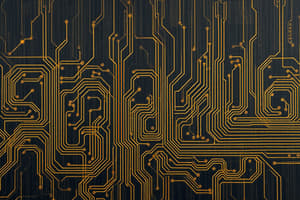Podcast
Questions and Answers
Which type of computing involves executing instructions sequentially on a single processor?
Which type of computing involves executing instructions sequentially on a single processor?
- Serial computing (correct)
- Distributed computing
- Parallel computing
- Concurrent computing
What is the main characteristic of parallel computing?
What is the main characteristic of parallel computing?
- A control/coordination mechanism is not needed
- Multiple compute resources are used
- Instructions execute simultaneously on different processors (correct)
- Instructions are executed sequentially
How is a problem typically broken down in parallel computing?
How is a problem typically broken down in parallel computing?
- Into a single instruction
- Into a control/coordination mechanism
- Into discrete parts that can be solved concurrently (correct)
- Into a series of instructions
What is the purpose of a control/coordination mechanism in parallel computing?
What is the purpose of a control/coordination mechanism in parallel computing?
What is the main difference between serial computing and parallel computing?
What is the main difference between serial computing and parallel computing?
Flashcards are hidden until you start studying
Study Notes
Serial Computing
- Executes instructions sequentially on one processor.
- Each task must complete before the next begins, leading to longer processing times for complex problems.
Parallel Computing
- Main characteristic: simultaneous execution of multiple tasks.
- Designed to increase computational speed and efficiency.
Problem Breakdown in Parallel Computing
- Complex problems are divided into smaller, independent tasks.
- Each task can be processed simultaneously on different processors.
Control/Coordination Mechanism in Parallel Computing
- Essential for managing and synchronizing tasks.
- Ensures tasks run efficiently and correctly, preventing conflicts and resource contention.
Differences Between Serial and Parallel Computing
- Serial computing processes tasks one at a time; parallel computing handles multiple tasks simultaneously.
- Parallel computing typically results in faster processing for large-scale problems compared to serial computing.
Studying That Suits You
Use AI to generate personalized quizzes and flashcards to suit your learning preferences.



